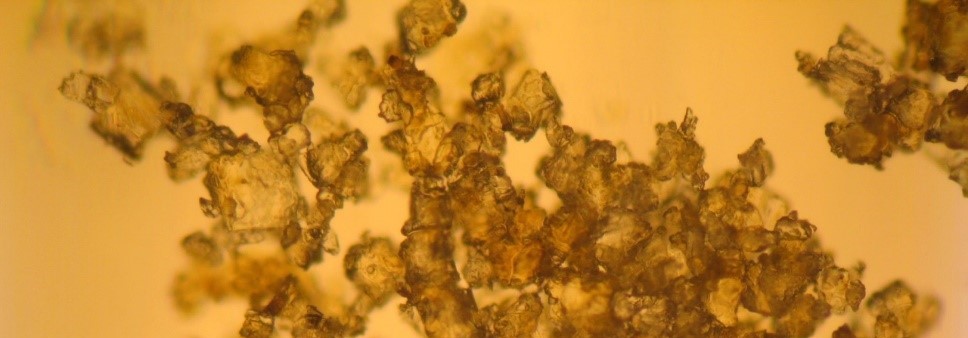If you are going through all of the effort to spray your crop, wouldn’t you want to make sure you are maximizing your impact?
Incorporating foliar application into your program in the spring gives your plants an added boost. By using fulvic acid, in addition to a granular application of humic in the spring and fall, you begin to address soil and seasonal deficiencies. There are many factors that go into deciding what products you could use when deciding to do a foliar application to your plants. For maximum impact, with the least amount of effort – think fulvic.
Fulvic acids have the lightest molecular weight, the smallest molecule, are the most soluble and have highest CEC fraction of the humic spectrum. These factors enable you to apply it at a lower rate. These organic acids carry a large amount of dissolved oxygen, and are excellent chelators. This makes fulvic acid a prime candidate for using in foliar feeding applications.

Four reasons to think Fulvic first
- Fulvic acids help to break the surface tension of water.
- Water is strongly polar, the depolarizing effects of fulvic acid, with its highly charged compounds, effectively help to reduce the surface tension of water. It’s kind of like making water wetter which means more surface area contact, which means more product coverage of the leaf you are applying the fulvic to.
- Water is strongly polar, the depolarizing effects of fulvic acid, with its highly charged compounds, effectively help to reduce the surface tension of water. It’s kind of like making water wetter which means more surface area contact, which means more product coverage of the leaf you are applying the fulvic to.
- Fulvic acids are superior chelators.
- The amphoteric nature of fulvic acids (both positively and negatively charged) form strong complexes, especially with metal micronutrients
- The amphoteric nature of fulvic acids (both positively and negatively charged) form strong complexes, especially with metal micronutrients
- With a CEC of over 500 meq, these strong organic chelators complex nutrients and help to carry throughout plant tissue rapidly.
- An advantage to adding an organic chelator, such as a high quality fulvic acid, to your plant nutrition program is that fulvic acid forms a four-point bond with the elements it chelates. Unlike synthetic chelators, fulvic acids chains can be absorbed right into the plant.
- An advantage to adding an organic chelator, such as a high quality fulvic acid, to your plant nutrition program is that fulvic acid forms a four-point bond with the elements it chelates. Unlike synthetic chelators, fulvic acids chains can be absorbed right into the plant.
- Fulvic acids help to build biomass.
- Fulvic acids contain aromatic carbon rings, which are the building blocks for cellular development. The more biomass (leaf and root surface area) that a plant has, means more photosynthesis and ultimately leads to an increase in yield.
Applications of Fulvic acids
Here are some typical ways fulvic acids are utilized in foliar applications:
- Herbicide – burn off
- Adding fulvic helps to increase herbicide efficacy with its high CEC chelation ability.
- It can also contribute to rate reduction practices when conditions permit. As mentioned above, fulvic and its superior chelation abilities, carries metal compounds into the leaf faster, thus helping with herbicide efficacy and encourages a more rapid weed kill.
- Fungicide timing
- Fulvic acid increases the deposition and residence time of active ingredients in fungicides by making them more available to the leaf. The low molecular weight and small molecule size of fulvic is a great way to increase product efficacy and inhibit spread of fungal hyphae.
- Fulvic acid increases the deposition and residence time of active ingredients in fungicides by making them more available to the leaf. The low molecular weight and small molecule size of fulvic is a great way to increase product efficacy and inhibit spread of fungal hyphae.
- Foliar micronutrients
- Noticing a leaf deficiency? Pair fulvic acid with your appropriate micro nutrients to help with efficiency and uptake.

Now, there are a few things that you should consider when adding fulvic to your program
- Limit foliar applications under high powered artificial light. Spraying under these conditions can create a lens effect and magnify light creating burn spots
- Fulvic acid can really “heat up” herbicide. So, we do not offer a recommendation for in crop application of fulvic acid with herbicide to avoid any phytotoxicity damage
But don’t forget some of the other ways fulvic acids are utilized, such as:
- Blended with liquid starter fertilizers
- Low molecular weight and no carbon means no precipitate formation, a low risk way to supercharge your starter
- Seed treatment
- Blended with liquid starter fertilizers
- Fulvic acids will help seeds imbibe more moisture leading to faster / vigorous germination
- The complex organic acids also contribute to stress reduction and drought tolerance during early crop development
Expected results and additional benefits you can observe when using fulvic in your foliar program
- Accelerated uptake of foliar products
- Fulvic acid produces hormonal and auxin like responses all by itself
- Potentially lower rates of active ingredients due to increased uptake efficiency
- Organically chelate nutrients
With all the benefits that fulvic acids provide, with its high CEC and chelation ability, to its various mechanisms to enhance spray efficiency; the question can soon become “why aren’t you using fulvic acid in your foliar program?”
